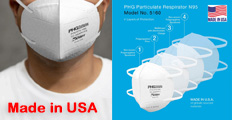



Find all of your laboratory and workplace safety supplies at Safety Emporium!
 Peroxide |
 Glossary Index |
 Phlegm |
| MSDS Topics |
Free Sites | FAQ's | Regulations | Glossary | Software | Suppliers |
| Books | Forum | Poll | Fun stuff | Quiz | Store | |
| Understand your MSDS with the MS-Demystifier | Search ALL our MSDS info | |||||
The pH of a solution is the negative logarithm of the hydrogen ion (H+) concentration (in moles per liter = molarity). Chemists write "hydrogen ion concentration" as [H+].
pH tells you whether a solution is acidic, basic or neutral. The corresponding ranges are:
For strong acids or bases, these values may actually be higher than 14 or lower than 0, but the 0-14 range is most commonly encountered.
The pH scale is logarithmic. That means each change of one in pH value is 10 times more or less acidic. Therefore, a substance with a pH of 2 is 1,000 times more acidic than one with a pH of 5.
The pH values of some common substances are given in the table below.
| Substance | Typical pH | [H+], M |
|---|---|---|
| Stomach acid (gastric juices) | 1.4 | 0.0398 |
| Lemon juice | 2.4 | 0.00398 |
| Vinegar | 3.0 | 1 x 10-3 |
| Tomatoes | 4.2 | 6.31 x 10-5 |
| Water exposed to air | 5.5 | 3.16 x 10-6 |
| Pure water | 7.0 | 1 x 10-7 |
| Blood or tears | 7.4 | 3.98 x 10-8 |
| Baking soda | 8.4 | 3.98 x 10-9 |
| Household ammonia | 11.5 | 3.16 x 10-12 |
| Household bleach | 12.5 | 6.31 x 10-13 |
pH can be measured in many different ways. A simple example is litmus paper which can tell you if a solution is basic or acidic. Other fast and inexpensive indicator papers and reagents can also be used. Examples include phenolphthalein, bromophenol blue, methyl red and gentian violet (see Further Reading below for more). Electronic pH meters can provide very accurate pH determinations over a wide range of hydrogen ion concentrations, but cost more than simple indicators.
Finally, note that the concept of pH is technically/generally correct only for dilute solutions (say, 0.001 M and below). As the concentration of a dissolved substance, in this case, H+ becomes greater, chemists use a concept called activity instead. This is because ions have charge, and when there are enough ions in the solution, they begin to interact in ways that may affect their availability to interact with other species. But for the purposes that most of need on an MSDS, pH works just fine.
Safety Data Sheets will list the pH of a substance, if known and applicable, in Section 9 (physical and chemical properties). It is important to know the pH of substances that may be corrosive or could react with incompatible materials; such information will be found in Section 10 (stability and reactivity). For example, acids and bases should not be stored or used near each other as their accidental combination could generate a huge amount of heat and energy, possibly resulting in an explosion. Section 6 (accidental release measures) will provide critical information if the material is spilled.
pH is also important to know in case you spill the material on your skin or eyes. Whenever a substance enters the eye, flush with water for 15 minutes and get prompt medical attention. If a basic substance enters the eye this is particularly important as basic materials tend to cause worse eye damage and are harder to flush out of the eye tissues than acidic materials.
See also: acid, base, eye wash.
Additional definitions from Google and OneLook.
Entry last updated: Saturday, January 7, 2023. This page is copyright 2000-2025 by ILPI. Unauthorized duplication or posting on other web sites is expressly prohibited. Send suggestions, comments, and new entry desires (include the URL if applicable) to us by email.
Disclaimer: The information contained herein is believed to be true and accurate, however ILPI makes no guarantees concerning the veracity of any statement. Use of any information on this page is at the reader's own risk. ILPI strongly encourages the reader to consult the appropriate local, state and federal agencies concerning the matters discussed herein.